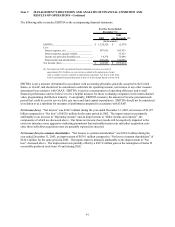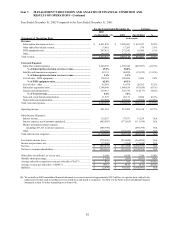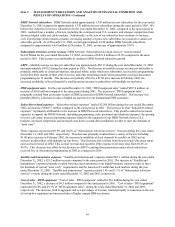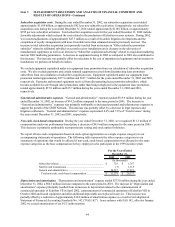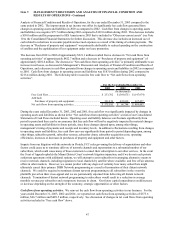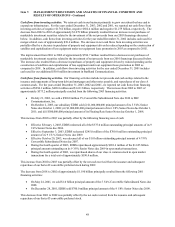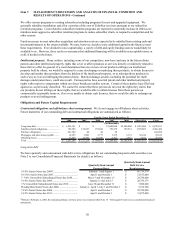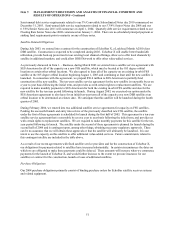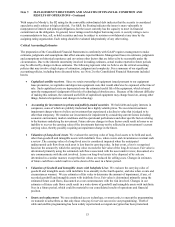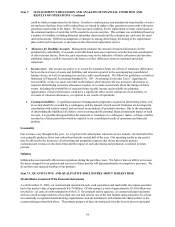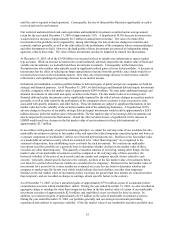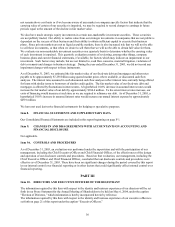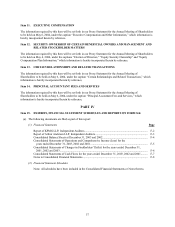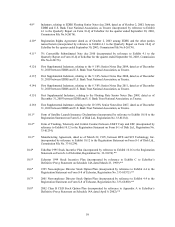Dish Network 2003 Annual Report Download - page 54
Download and view the complete annual report
Please find page 54 of the 2003 Dish Network annual report below. You can navigate through the pages in the report by either clicking on the pages listed below, or by using the keyword search tool below to find specific information within the annual report.Item 7. MANAGEMENT’S DISCUSSION AND ANALYSIS OF FINANCIAL CONDITION AND
RESULTS OF OPERATIONS - Continued
49
Other Liquidity Items
Subscriber turnover. If a subscriber disconnects, or churns, from our DISH Network service there is an immediate
impact to our ongoing revenue stream. In addition, if a subscriber churns early in the average subscriber life-cycle,
we cannot recover the costs related to the acquisition of the subscriber. Our percentage monthly churn for the year
ended December 31, 2003 was approximately 1.57%, compared to our percentage churn for the same period in 2002
of approximately 1.59%. As a result of our dispute with Viacom, as previously described, we will have a temporary
increase in subscriber churn during the first quarter of 2004. While there can be no assurance, the Viacom dispute is
not expected to have a material effect on overall net subscriber additions in 2004.
Impacts from our litigation with the networks in Florida, FCC rules governing the delivery of superstations and other
factors could cause us to terminate delivery of network channels and superstations to a substantial number of our
subscribers, which could cause many of those customers to cancel their subscription to our other services. In the event
the Court of Appeals upholds the Miami District Court’s network litigation injunction, and if we do not reach private
settlement agreements with additional stations, we will attempt to assist subscribers in arranging alternative means to
receive network channels including migration to local channels by satellite where available, and free off air antenna
offers in other markets. However, we cannot predict with any degree of certainty how many subscribers might
ultimately cancel their primary DISH Network programming as a result of termination of their distant network
channels. We could be required to terminate distant network programming to all subscribers in the event the plaintiffs
prevail on their cross-appeal and we are permanently enjoined from delivering all distant network channels.
Termination of distant network programming to subscribers would result in a reduction in average monthly revenue per
subscriber and a temporary increase in churn.
Increases in piracy or theft of our signal, or our competitors’ signals, also could cause churn to increase in future
periods. In addition, in April 2002, the FCC concluded that our “must carry” implementation methods were not in
compliance with the “must carry” rules. If the FCC finds our subsequent remedial actions unsatisfactory, while we
would attempt to continue providing local network channels in all markets without interruption, we could be forced by
capacity constraints to reduce the number of markets in which we provide local channels. This could cause a
temporary increase in churn and a small reduction in average monthly revenue per subscriber. Additionally, as the size
of our subscriber base continues to increase, even if percentage churn remains constant, increasing numbers of gross
new subscribers are required to sustain net subscriber growth.
Subscriber acquisition and retention costs. As previously described, we generally subsidize installation and all or a
portion of the cost of EchoStar receiver systems in order to attract new DISH Network subscribers. Our spending
for subscriber acquisition costs, and to a lesser extent subscriber retention costs, can vary significantly from period
to period and can cause material variability to our net income (loss) and free cash flow. Our average subscriber
acquisition costs were approximately $453 per new subscriber activation during the year ended December 31, 2003.
While there can be no assurance, we believe continued tightening of credit requirements, together with promotions
tailored towards subscribers with multiple receivers and advanced products, will attract better long-term subscribers.
Our subscriber acquisition costs, both in the aggregate and on a per new subscriber activation basis may materially
increase in future periods to the extent that we introduce more aggressive promotions if we determine that they are
necessary to respond to competition, or for other reasons.
We exclude equipment capitalized under our lease promotion from our calculation of subscriber acquisition costs. We
also exclude payments and certain returned equipment received from disconnecting lease promotion subscribers from
our calculation of subscriber acquisition costs. Equipment capitalized under our lease promotion totaled approximately
$108.1 million, $277.6 million and $337.7 million for the year ended December 31, 2003, 2002 and 2001, respectively.
Returned equipment received from disconnecting lease promotion subscribers, which became available for sale rather
than being redeployed through the lease promotion, together with payments received in connection with equipment not
returned, totaled approximately $30.2 million, $37.8 million and $15.7 million during the year ended December 31,
2003, 2002 and 2001, respectively. The decrease from 2002 to 2003 resulted from a greater percentage of returned
leased equipment being redeployed to new lease customers and relatively less of that equipment being offered for sale
as remanufactured equipment. As a result of recent changes in our equipment lease promotion, in 2004 we anticipate
an increase in the number of subscribers who lease rather than purchase equipment. The resulting anticipated increase
in capitalized costs is expected to more than offset the corresponding reduction in expensed subscriber acquisition
costs, and result in an overall increase in cash used to acquire subscribers during 2004.




